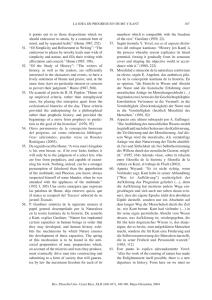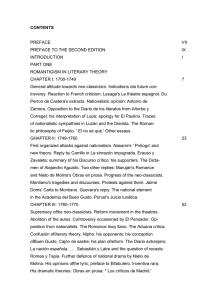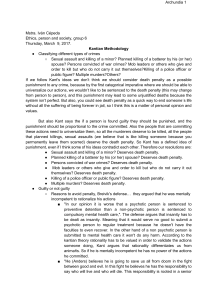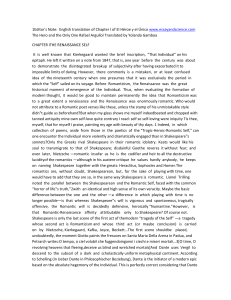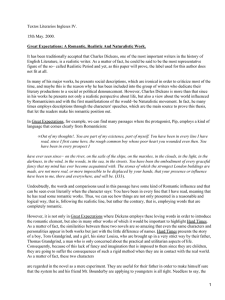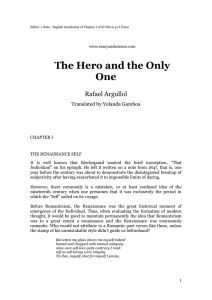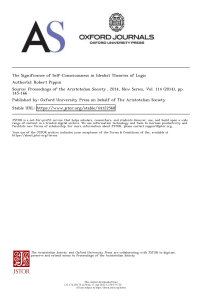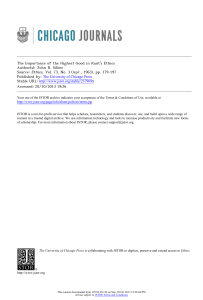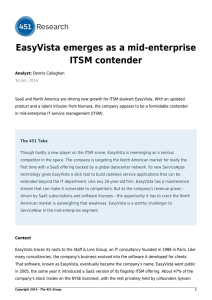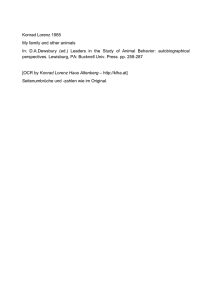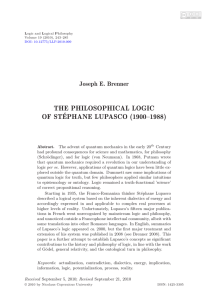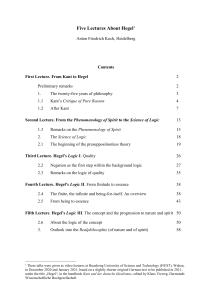THE ROMANTIC MOVEMENT
Anuncio
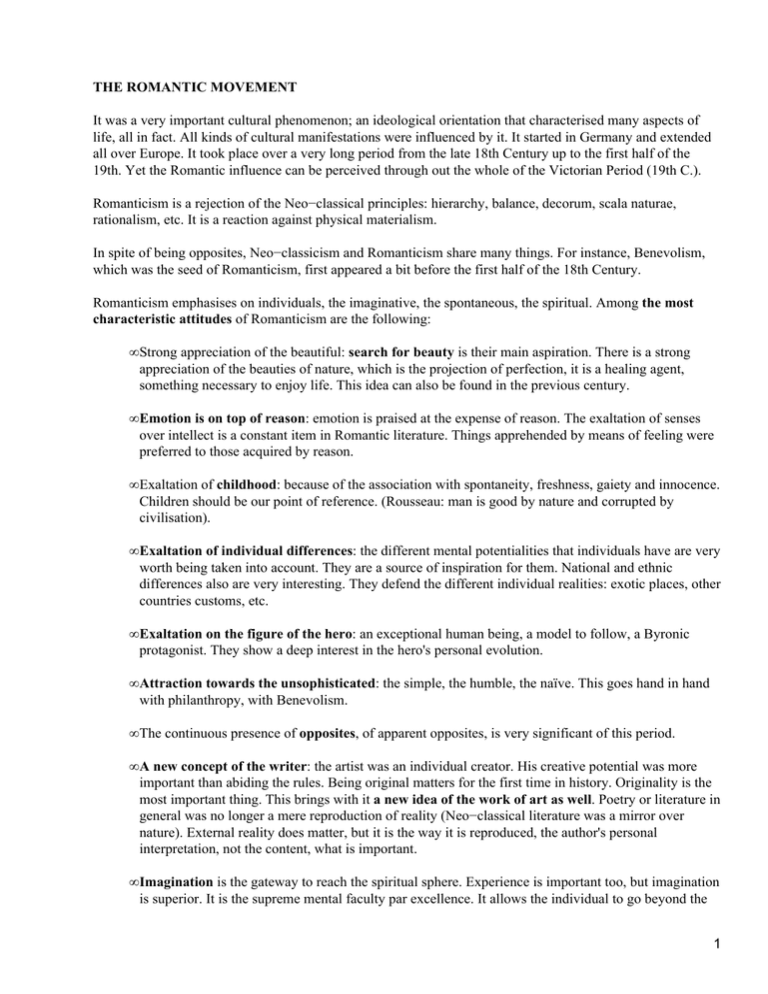
THE ROMANTIC MOVEMENT
It was a very important cultural phenomenon; an ideological orientation that characterised many aspects of
life, all in fact. All kinds of cultural manifestations were influenced by it. It started in Germany and extended
all over Europe. It took place over a very long period from the late 18th Century up to the first half of the
19th. Yet the Romantic influence can be perceived through out the whole of the Victorian Period (19th C.).
Romanticism is a rejection of the Neo−classical principles: hierarchy, balance, decorum, scala naturae,
rationalism, etc. It is a reaction against physical materialism.
In spite of being opposites, Neo−classicism and Romanticism share many things. For instance, Benevolism,
which was the seed of Romanticism, first appeared a bit before the first half of the 18th Century.
Romanticism emphasises on individuals, the imaginative, the spontaneous, the spiritual. Among the most
characteristic attitudes of Romanticism are the following:
• Strong appreciation of the beautiful: search for beauty is their main aspiration. There is a strong
appreciation of the beauties of nature, which is the projection of perfection, it is a healing agent,
something necessary to enjoy life. This idea can also be found in the previous century.
• Emotion is on top of reason: emotion is praised at the expense of reason. The exaltation of senses
over intellect is a constant item in Romantic literature. Things apprehended by means of feeling were
preferred to those acquired by reason.
• Exaltation of childhood: because of the association with spontaneity, freshness, gaiety and innocence.
Children should be our point of reference. (Rousseau: man is good by nature and corrupted by
civilisation).
• Exaltation of individual differences: the different mental potentialities that individuals have are very
worth being taken into account. They are a source of inspiration for them. National and ethnic
differences also are very interesting. They defend the different individual realities: exotic places, other
countries customs, etc.
• Exaltation on the figure of the hero: an exceptional human being, a model to follow, a Byronic
protagonist. They show a deep interest in the hero's personal evolution.
• Attraction towards the unsophisticated: the simple, the humble, the naïve. This goes hand in hand
with philanthropy, with Benevolism.
• The continuous presence of opposites, of apparent opposites, is very significant of this period.
• A new concept of the writer: the artist was an individual creator. His creative potential was more
important than abiding the rules. Being original matters for the first time in history. Originality is the
most important thing. This brings with it a new idea of the work of art as well. Poetry or literature in
general was no longer a mere reproduction of reality (Neo−classical literature was a mirror over
nature). External reality does matter, but it is the way it is reproduced, the author's personal
interpretation, not the content, what is important.
• Imagination is the gateway to reach the spiritual sphere. Experience is important too, but imagination
is superior. It is the supreme mental faculty par excellence. It allows the individual to go beyond the
1
world of experience in order to catch a glimpse of the divine.
• There is also an obsessive interest in folk culture: something picturesque is something attractive
because it is old and unspoiled. The past was something idealised because it would never come back.
They found tight connections between their thinking and the 'agricultural past'. They were also very
much interested in previous periods such as the Renaissance or the Middle Ages, which for them
were not so dark.
• We can also find a predilection for the mysterious: the awkward, the occult, all in all, a predilection
for the sublime. The sublime is something very close to beauty, but they make you feel differently.
Beauty infers peace, attraction and the sublime, like a storm for example, makes you feel fear, which
can also be very attractive. The sublime is the juxtaposition of both things: attraction and fear.
According to the Romantics, the sublime allows you to reach a vertical axis, to realise that we cannot
control the Universe. Another fantastic source for metaphor, for figurative language, for excessive
feelings, etc.
Formal Aspects:
Romanticism reacted against the heroic couplet and the rest of metrical forms of Neo−classicism. They used
different meters like blank verse in which there is no fixed rhyme although some kind of meter exists. (Free
verse = absolute freedom, no rhyme, no metrical pattern).
Another popular stanza was also the Spenserian Stanza, eight iambic pentameters and one alexandrine (6
iambic pentameters).
Romanticism had its origins in various movements that took place in the 18th Century, in the age of reason.
As far as aesthetics are concerned, the first half of the 18th Century saw a rebirth of the genres of the past
such as medieval romances, which were ballads and tales of chivalry. These dealt with individual heroism,
with the mysterious and the supernatural, like Sir Gawain, Beowulf, etc. This kind of literature is so
interesting to them because they reacted against the artificiality of classical literary forms.
Romanticism can be divided into two different faces:
The first face corresponds to the early Romantic period which was mainly concerned with establishing the
theoretical foundations of the movement. Poetry and Philosophical treatises are the main literary forms used
for defining Romanticism and its concepts.
The second face develops from the 1830's onwards and is concerned with the spread of cultural nationalisms.
As a consequence of this a renewed interest in the past, in origins sees the light. The past is idealised and
recreated. A new genre emerged: the historical Romance which makes an emphasis on the imaginative
component. The past is recreated with a touch of imagination, a good example of this kind of literature is Sir
Walter Scott's Waverly Novels ('Ivanhoe').
The Romantic Movement had its own peculiarities in each country but we can distinguish two main branches:
the German Romanticism which influences the whole of Europe except England, and the English
Romanticism.
The main differences between both of them are:
German Romanticism very much appreciated:
the sophisticated: the mystical, the subconscious
2
the abstract
art for art's sake
English Romanticism had an attraction for
the simple (every day affairs)
the concrete (practical things)
committed art (art that dealt with everyday affairs, politics, etc.)
The Germans were mainly affected by Idealism (critical − Kant and absolute − Hegel). English Romantics
were also influenced by these philosophical trends but they were also influenced by another ideological trend
which developed throughout the 18th Century: Empiricism.
English Empiricism: they laid emphasis on three main notions: external reality (matter), experience and
human senses. Two are the most important empiricist thinkers: John Locke and Hartley (his disciple). Locke
said that our mind is empty when we are born and that our knowledge is the result of two different processes:
the sensation: you acquire experience by means of using your senses through which you get impressions.
Their favourite sense is sight. Our mind automatically works upon those impressions and makes ideas, simple
ideas.
Then the second process is association or reflection through which we produce complex ideas.
Hartley developed Locke's ideas to the ultimate consequences and said thought that the human mind was a
machine. This implies that for him and his followers the older we get the weaker our mind becomes. This is
why childhood is given such importance. The child's mind is more powerful for them.
Romantics did not agree with the empiricists at this point.
The German philosophical trends:
Germany was the cradle of Romanticism and of German Idealism. Kant and Hegel are the most representative
philosophers of this movement. Its origins could be found some years before in the works of Herder, which
contained the seeds of Idealism. Yet, Kant is the father of Idealism because he began a new era for
philosophical thinking. By reconsidering and subsuming previous philosophical trends which were normally
regarded as opposites, he creates something new. He puts together trends like Rationalism, Empiricism and
the ideas of Rousseau.
Kant was an heir to Rationalism. He was very much influenced by it and so he relied on the principles of
'sufficient reason' (for everything there is a reason why this thing should be rather than not to be).
He was also very much interested in Hume's work, a very important empiricist. The main idea that interested
him was Hume's conclusion of human beings not being able to demonstrate the existence of God with logic
alone. Kant also denied the Ontological Argument that is why he was called a sceptical.
The Ontological Argument was established by St. Anselm and he said that given that we have the idea of God,
God exists.
A third main influence upon Kant was exerted by Rousseau. He was a very different kind of thinker, a counter
3
influence to the Rationalists, to the empiricists, to Hume. He rejected the predominance of reason over
emotions (Emile). 'Man is good by nature, consequently, children should be brought up in the country,
surrounded by nature and learn from experience. Nature purifies and civilisation corrupts. Nature is a model to
imitate'.
These three philosophical trends are completely opposite to each other but Kant uses the main ideas of each
and innovates philosophical thinking. Like Rousseau Kant believed that, although human reason cannot
justify the existence of a spiritual world, the spiritual world existed because we feel that God exists.
Consequently Kant distinguishes two kinds of reason: theoretical or pure reason and practical reason.
Theoretical reason: it dealt with all the principles that made scientific knowledge possible.
Practical reason: it ruled the ethical and moral principles and tried to justify the principles that should rule
human actions.
Kant tried to reconcile the world of metaphysics and the world of science. He believed in the existence of God
and in the categorical imperative: every human being should behave in such a way that his behaviour can be
taken as a model to imitate. Why? because we have to. This is what delivers the idea of 'duty' on the
Romantics. He merges two concepts that previously had been separated: 'Whenever reason fails, faith
provides the answer'.
His followers insisted upon the idealist components, but it was Hegel who carried idealism to its ultimate
consequences. He was the father of Absolute Idealism: 'everything is nothing but spirit that innacts itself in
everything. For Hegel it is not the human mind that apprehends the Absolute Spirit, it is the Absolute Spirit
that exists in the human mind. Knowledge, according to Hegel, consists on moving towards unity in spite of
differentiation. The acquirement of knowledge is done through the Dialectical Scheme: every hypothesis
implies the existence of its antithesis and their integration results into a synthesis. The synthesis becomes
another hypothesis with its antithesis, etc. etc. The ultimate idea is the Absolute Spirit. Our main aim is to
reach a vertical axis in the pyramid.
Absolute Spirit
Philosophy
Religion
Art and culture
Nature
LITERATURA S. XIX 15/07/
1
1
1
4
